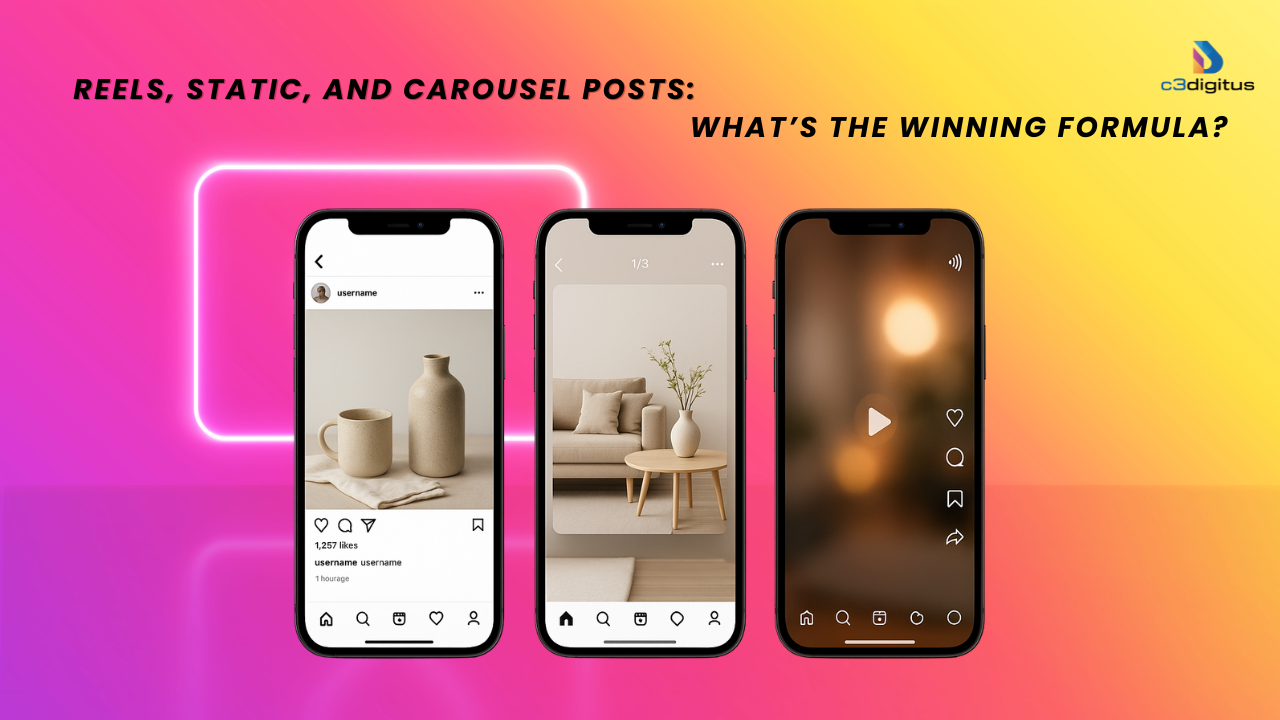Let’s face it, just showing up on social media isn’t enough anymore. In 2025, every scroll, swipe, and second counts. The real challenge? Knowing what kind of post will actually move the needle. Reels grab attention, Carousels build connection, and Static Posts reinforce your brand identity. Mastering how and when to use each format is the secret to turning followers into engaged, loyal fans.
1. Understanding the Formats
Static Posts
A static post is the most straightforward type of social media content: a single image, photo, or graphic shared directly to a feed. Think of it as the “classic” social media post—whether it’s a product shot, a branded infographic, a company announcement, or even a motivational quote.Static posts are the foundation of most social feeds because they’re quick to produce, easy to consume, and permanent (unless deleted). They’re also versatile—you can use them to showcase products, highlight team culture, share customer testimonials, or communicate key brand messages.
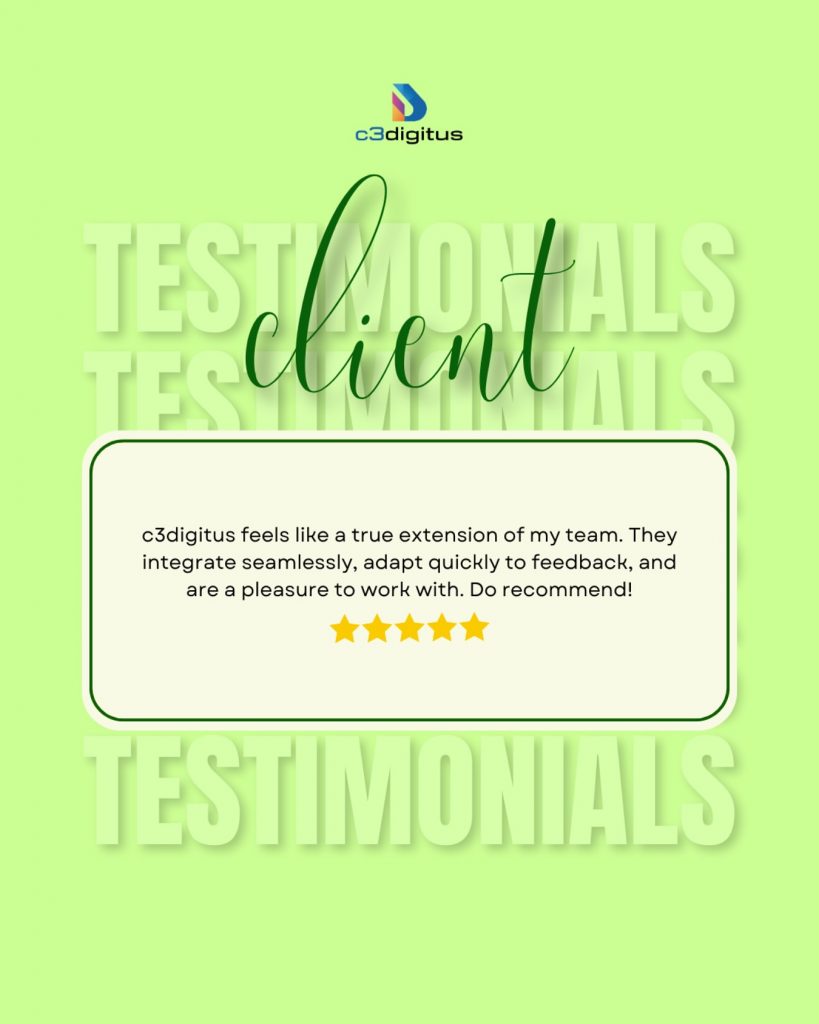
However, in 2025, static content faces an uphill battle for visibility. With algorithms prioritizing video and interactive formats, single-image posts often struggle to achieve organic reach unless paired with strong visuals, timely messaging, or paid promotion.
These shifts reflect a broader pattern in Instagram’s latest updates for 2025, where video-driven engagement continues to redefine how content surfaces on the feed.
That said, when done well, static posts remain effective for brand consistency, aesthetic storytelling, and quick updates.
Platforms: Instagram, Facebook, LinkedIn, X (Twitter), Pinterest.
What Is a Carousel on Instagram?
A carousel post is a multi-slide format that allows users to swipe through a sequence of images, graphics, or short videos within a single update. Instead of telling your story in one frame, you can break it down into several parts, making the content more engaging and digestible.

Carousels are especially popular on Instagram, Facebook, and LinkedIn, where they serve as a powerful tool for education, storytelling, and product showcases. For example, a brand might use a carousel to highlight the steps of a tutorial, showcase different angles of a product, or share key slides from a presentation.
How Does a Carousel Work?
- First Slide Visibility: The first image or video appears in the feed just like a static post.
- Swipe-to-Explore: Users can swipe left to view additional slides, often creating a “storytelling effect.”
- Mixed Media: You can combine both images and videos in a single carousel, adding variety.
- Algorithm Advantage: If a user doesn’t engage with the first slide, the platform may resurface the post later with a different slide, giving it a second chance at visibility.
- Engagement Boost: Carousels naturally encourage interaction, increase dwell time, and are more likely to be saved or shared because of their educational or narrative value.
Carousels strike a balance between depth and accessibility. They allow you to deliver detailed information without overwhelming your audience in one frame, making them a go-to format for brands that want to teach, inspire, or guide users step by step.
Platforms: Instagram, Facebook, LinkedIn (document carousels), Pinterest idea pins.
Reels (and Short-Form Video Equivalents)
Reels are short-form vertical videos—typically 15 to 90 seconds long—created for fast, snackable consumption. They’re designed to capture attention quickly and keep viewers engaged through music, text overlays, effects, and trending audio. Unlike disappearing content such as Stories, Reels are permanent (unless deleted), giving them a longer shelf life.
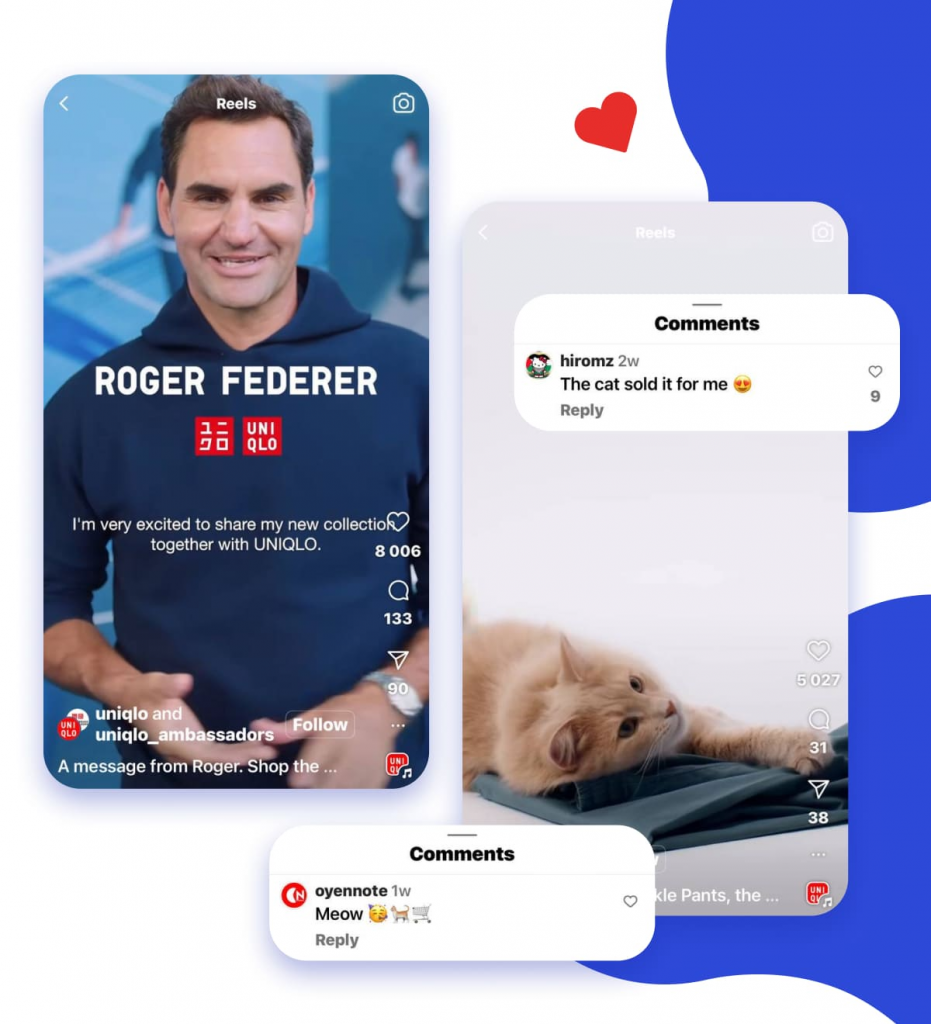
On Instagram, Reels have their own dedicated tab on a profile, but they also appear in the Explore page and Reels feed, making them highly discoverable. This discoverability, combined with Instagram’s algorithmic push, is what makes Reels one of the strongest tools for reach and new audience growth.
But “Reels” aren’t exclusive to Instagram. In fact, short-form video has become a cross-platform trend:
- TikTok is the pioneer of short-form video, with an entire platform built around it. Its algorithm is unmatched in surfacing content to the right audience.
- YouTube Shorts emerged as YouTube’s direct response to TikTok and Instagram Reels, letting creators reach new viewers in bite-sized format while connecting to their long-form content.
- Facebook Reels are integrated directly into feeds, making it easy to repurpose Instagram Reels and expand their reach to another large audience.
Reels and other short-form video formats thrive because they align with modern attention spans and content consumption habits. They’re entertaining, highly shareable, and often favored by algorithms, making them ideal for building awareness, going viral, or connecting with younger demographics.
Platforms: Instagram, TikTok, YouTube, Facebook.
Stories (for Context)
Many users mix up Reels and Stories, but while both use a vertical, mobile-friendly format, they serve very different purposes. Understanding the distinction helps brands and creators choose the right format for their goals.
Difference Between Reel and Story
- Reels: Permanent (unless deleted), highly discoverable through Explore or dedicated feeds, and designed to reach new audiences. They’re optimized for virality, visibility, and brand awareness.
- Stories: Temporary, disappearing after 24 hours unless saved to Highlights. They’re primarily geared toward engaging with your existing followers. With interactive tools like polls, quizzes, question boxes, and stickers, Stories foster casual, real-time connections rather than broad reach.
In short:
- Both are vertical, short-form, and mobile-first.
- Reels = Growth & Discovery.
- Stories = Engagement & Connection.
Together, they complement each other. Reels cast a wide net to bring new eyes to your profile, while Stories help deepen relationships with the audience you already have.
Live Video (The Real-Time Connection)
While not a traditional feed format, Live Video (on platforms like Instagram, Facebook, and YouTube) is a critical tool for driving real-time engagement and connection. It falls primarily into the Middle of Funnel (Consideration) stage.
- Purpose: To foster two-way dialogue, answer user questions directly, provide in-depth demonstrations, and humanize the brand.
- Key Benefit: High dwell time and authentic interaction. Users feel a deeper connection to a brand when they see the people behind it speaking directly to them.
- Strategy: Use Reels to drive awareness of an upcoming Live session, and Stories to post reminders and question boxes beforehand.
2. Instagram Carousels vs Reels: Which Wins?
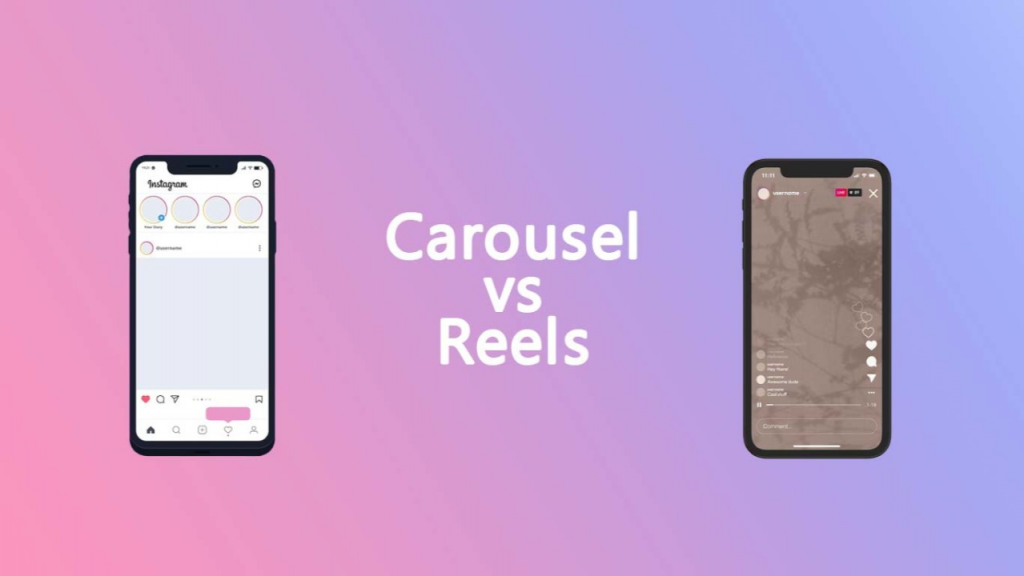
Instagram remains a central platform for the debate of Carousels vs Reels.
- Reels dominate reach. Data shows they are pushed heavily by Instagram’s algorithm into Explore and the Reels tab, reaching beyond followers.
- Carousels dominate engagement. They earn more saves, shares, and comments, especially for educational or storytelling content.
For example:
- A Reel might introduce your product to thousands of new users.
- A Carousel could then break down features, pricing, or use cases to build trust and conversions.
In the US, where competition on Instagram is fierce, most brands find that balancing both formats—using Reels for awareness and Carousels for depth—delivers the best ROI.
3. Carousel and Reel Beyond Instagram
While much of the conversation centers on Instagram, both carousels and short-form video exist across platforms.
- LinkedIn Carousels: These are document-based slide decks, ideal for professional storytelling, thought leadership, or step-by-step breakdowns. They perform exceptionally well for B2B audiences.
- Facebook Carousels: Often used in ads to showcase multiple products, but also available for organic posts. They’re highly interactive for e-commerce.
- TikTok: No carousel, but TikTok functions as a “Reels-only” platform. The format is purely video, but carousel-style storytelling can be simulated using editing techniques.
- YouTube Shorts: Another Reels equivalent, with growing adoption in the US.
- Pinterest Idea Pins: Function like a hybrid between carousel and story, letting users swipe through images or videos in a multi-slide format.
So, while “Reels” may be Instagram’s term, the short-form video vs multi-slide content debate applies across multiple channels.
This cross-platform adaptability also explains why brands expanding beyond Instagram often see compounding reach, especially when tailoring formats to each network’s strengths, as outlined in the leading social platforms for brand growth.
4. Static vs Carousel vs Reel: A Comparative Look
Here’s how the three formats stack up across different goals:
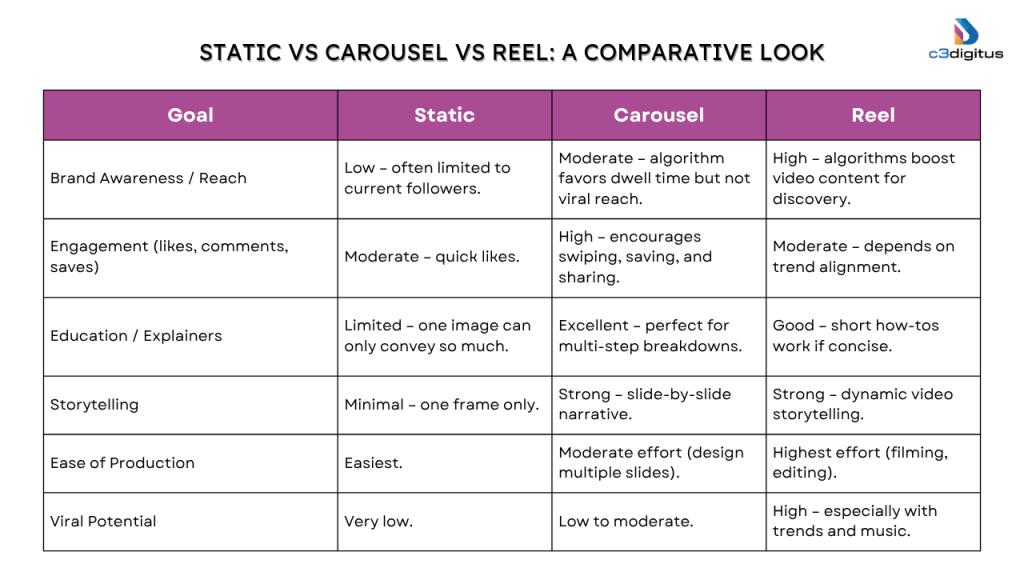
5. Pros and Cons of Each Format
Static Posts
Pros:
- Easy to create: Static posts typically involve a single image or graphic, making them quick and straightforward to produce, requiring minimal editing or animation skills.
- Strong for aesthetics and branding: Perfect for visually showcasing your brand identity through logos, color palettes, or product images. They help maintain a cohesive look across your feed.
- Quick updates: Ideal for announcements, quotes, promotions, or simple messages that don’t require extensive explanation.
- Still relevant on platforms like LinkedIn: Professional networks still value clean, informative visuals for thought leadership, industry insights, and updates.
Cons:
- Lowest reach and engagement: Static posts are often less prioritized by social media algorithms, which favor more interactive content.
- Easily overlooked: In feeds dominated by dynamic video content, static images can fail to capture attention, making them less effective for virality.
Platform Tips:
- Instagram: Use for branding, product showcases, and promotional campaigns.
- Facebook: Works well for simple updates or promotions, especially if paired with paid ads.
- LinkedIn: Perfect for company updates, announcements, and professional branding.
- Pinterest: Static images perform well due to search-driven discovery.
Carousels
Pros:
- Excellent for education and storytelling: Carousels allow multiple slides, enabling you to break down complex ideas, tell a story step by step, or create tutorials.
- Higher engagement rates: People are more likely to swipe through, save, comment, or share carousel posts, boosting interaction.
- Showcase products effectively: Each slide can highlight different features, specifications, or use cases, making them ideal for product-focused content.
- Builds trust with deeper content: Offering in-depth insights or detailed explanations positions your brand as knowledgeable and reliable.
Cons:
- Time-consuming to design: Crafting cohesive slides requires careful planning, consistent design, and sometimes more advanced graphic skills.
- Lower discoverability: While engagement is higher, carousel posts tend to be less favored by algorithms for reach compared to Reels or short-form videos.
Platform Tips:
- Instagram: Best for educational content, tips, and product walkthroughs.
- Facebook: Carousel ads are highly effective for e-commerce campaigns.
- LinkedIn: Document uploads are ideal for B2B thought leadership, tutorials, or step-by-step guides.
- TikTok / YouTube Shorts: Multi-segment editing can mimic carousel-style storytelling.
- Pinterest: Idea Pins replicate carousel functionality and work well for tutorials or step-by-step storytelling.
Reels / Short-Form Video
Pros:
- Highest reach and discoverability: Platforms like Instagram and TikTok prioritize Reels, helping content reach new audiences beyond your followers.
- Perfect for trends and entertainment: Short videos can leverage trending sounds, memes, and creative effects to boost brand visibility.
- Highly shareable: Users are more likely to repost or share engaging short videos, which helps grow brand awareness organically.
- Algorithm-friendly: Social media platforms actively push video content, giving it preference in exploring pages and feeds.
Cons:
- Time-intensive to produce and edit: Creating high-quality videos often requires scripting, filming, and editing, which demands more resources than static content.
- Short attention spans: Videos must capture attention within the first few seconds, requiring strong hooks and concise storytelling.
- Not ideal for complex content: While great for trends and awareness, short videos can struggle to convey detailed or technical information effectively.
Platform Tips:
- Instagram: Use Reels to maximize reach and tap into trending content.
- Facebook: Reels are being integrated into feeds—test engagement.
- LinkedIn: Video is growing but less viral; use for storytelling or thought leadership snippets.
- TikTok: Entirely video-driven—your Reels strategy should be mirrored here for trends and entertainment.
YouTube Shorts: Repurpose existing Reels or TikTok content for maximum efficiency.
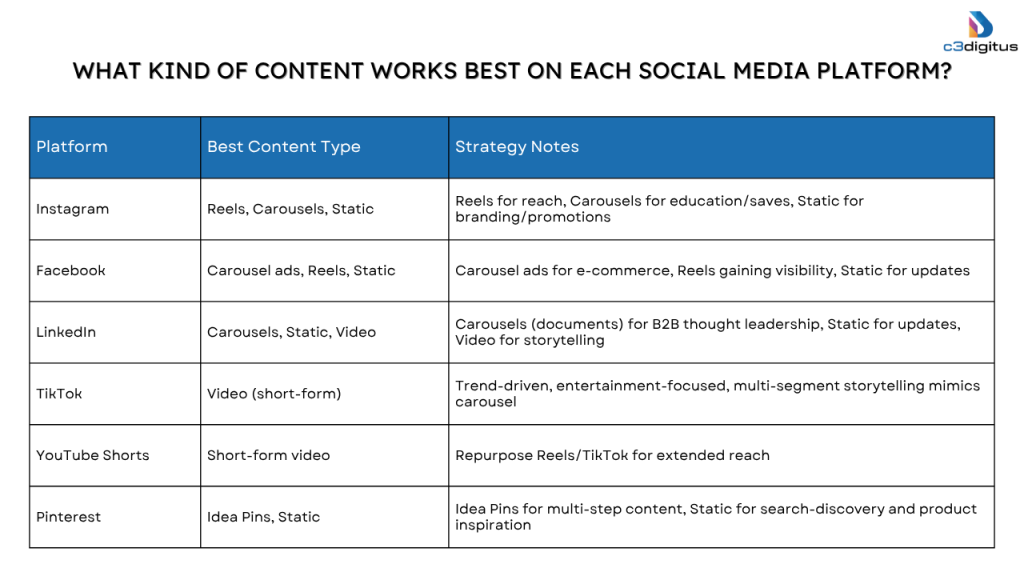
7. When to Use What (Strategic Approach)
Think of each content type—Reels, Carousels, and Static Posts—as a strategic tool for a different stage of your marketing funnel. Each serves a distinct purpose in guiding your audience from awareness to conversion.
1. Top of Funnel (Awareness): Reels / Short-Form Video
Goal: Capture attention and reach new audiences.
At the awareness stage, the primary objective is visibility. Reels and short-form videos are your best tools to achieve this. These quick, engaging clips help introduce your brand, showcase your personality, and spark curiosity among potential customers.
- Why it works: Social algorithms prioritize video content, giving Reels greater reach and discoverability.
- What to post: Trending challenges, product demos, behind-the-scenes moments, or storytelling clips that humanize your brand.
Example: A 15-second Reel showing a trending product in action, paired with upbeat music and quick transitions to grab attention instantly. For a real-world parallel, Duolingo’s trend-driven, viral Reels focus solely on entertainment and brand personality, resulting in millions of new followers by achieving massive reach outside their existing community.
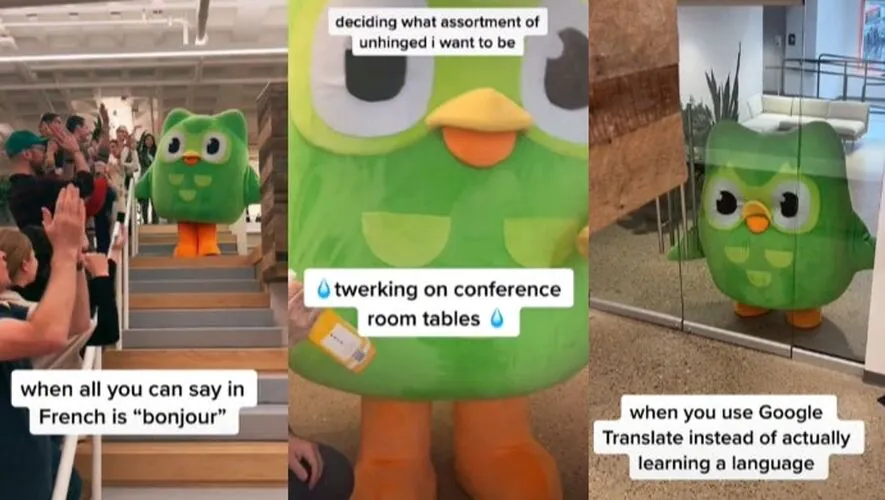
2. Middle of Funnel (Consideration): Carousels / Multi-Image Posts
Goal: Educate, inform, and nurture interest.
Once awareness is established, move audiences deeper into the funnel using Carousel posts. These allow you to tell a story, explain key features, share customer experiences, or provide industry insights that position your brand as an authority.
- Why it works: Carousels encourage users to engage more deeply by swiping through slides, which boosts saves, shares, and comments.
- What to post: Tutorials, comparison charts, product benefits, user testimonials, or informative “how-to” guides.
Example: A Carousel post breaking down the top benefits of a product, featuring visuals of customer reviews, use cases, and a call-to-action like “Save this post for later.” Brands like BuzzFeed Tasty use carousels to showcase recipes step-by-step, maximizing “Saves” and dwell time, as users repeatedly swipe through the slides to refer to the instructions.
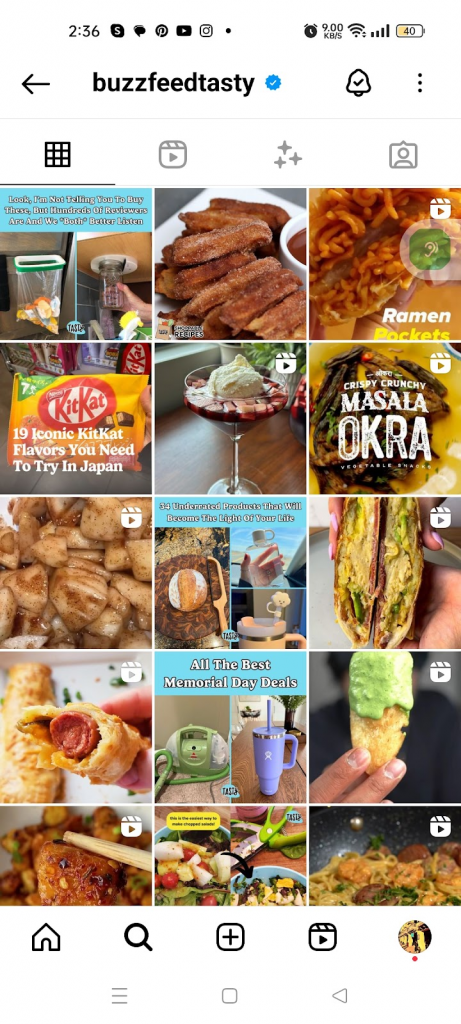
3. Bottom of Funnel (Conversion & Trust): Static Posts
Goal: Reinforce credibility and drive action.
At the decision-making stage, your audience needs reassurance. Static posts—simple, clear, and branded—are effective in building trust and driving conversions. They create visual consistency and convey reliability.
- Why it works: Clean, professional imagery and concise messaging help strengthen brand perception and inspire confidence, serving as a reliable and professional anchor in a fast-paced feed. They feel more ‘official’ and authoritative than rapid-fire video, lending weight to final CTAs.
Yet, creators still struggle when visuals or captions miss the mark, a pattern explored in why some Instagram posts underperform and how small adjustments can dramatically shift engagement.
- What to post: Customer testimonials, product close-ups, promotional graphics, or posts emphasizing quality and trust.
Example: A static post featuring a strong product image, your logo, and a caption reinforcing your brand message with a direct link or CTA like “Shop Now” or “Learn More.” Luxury and wellness brands like Glossier rely on clean, minimalist static imagery to reinforce brand aesthetic and perceived quality, lending authority to their final conversion call-to-action.
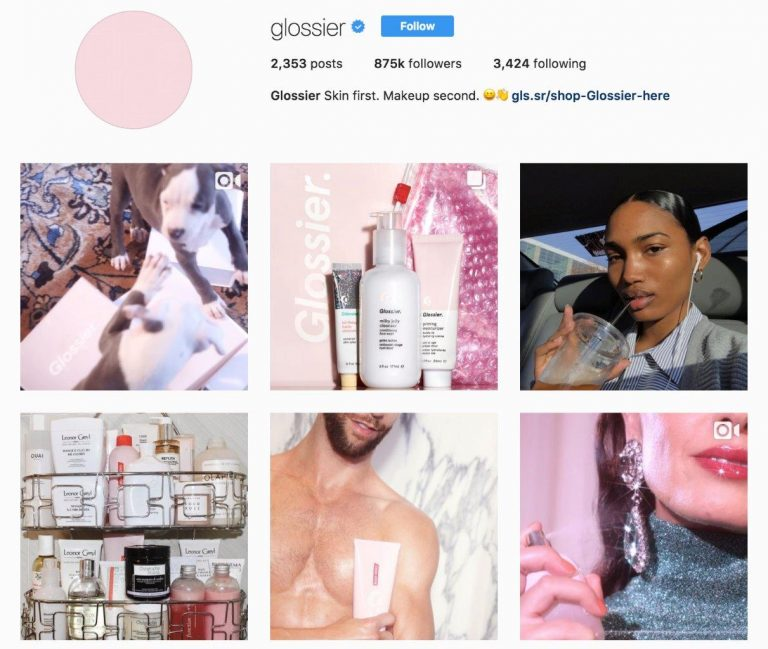
8. Tips for Maximizing Each Format
Reels / Short-Form Video
Goal: Capture attention and boost discoverability.
- Hook viewers within the first 3 seconds: The beginning of your video determines whether people keep watching. Start with a strong visual, bold text, or an intriguing statement.
- Use trending audio: Leveraging popular sounds or songs increases the chance of your Reel being surfaced to a wider audience through platform algorithms.
- Always add captions: Many users watch videos on mute, so captions ensure your message is clear and accessible.
- Keep it concise: Aim for 15–30 seconds. Deliver one clear idea rather than overwhelming viewers with too much information.
Carousels / Multi-Image Posts
Goal: Educate, tell stories, and drive engagement.
- Make the first slide irresistible: The cover image should act like a headline—bold text, bright colors, or a question that hooks curiosity.
- Ensure a logical flow: Organize slides so they tell a clear story—from problem to solution or idea to takeaway—encouraging swipes through every frame.
- End with a strong call-to-action (CTA): The last slide should prompt engagement—like “Save this post,” “Share with a colleague,” or “Visit our website.”
- Maintain design consistency: Use uniform fonts, colors, and spacing so each slide feels cohesive and professional.
Static Posts
Goal: Strengthen branding and consistency.
- Use bold, high-quality visuals: A clean, striking image or graphic helps you stand out in busy feeds.
- Keep captions informative yet concise: Provide value—whether it’s an announcement, quick insight, or highlight—but avoid cluttering the message.
- Maintain consistent aesthetics: Stick to your brand’s color palette, typography, and tone to create a recognizable identity across posts.
- Optimize for platform dimensions: Ensure images are formatted correctly (e.g., 1080 x 1350 pixels for Instagram) to maintain visual quality.
Pro Tip: Repurpose Content Across Formats
Maximize your content investment by adapting one idea for multiple formats:
- A Reel can be clipped into a Story for quick, digestible moments.
- A Carousel can be split into several Static Posts, each focusing on a single key takeaway.
- A Static Post can become the final slide of a Carousel, reinforcing your message or call-to-action.
- A Reel highlighting product use can be turned into a Carousel explaining features in more depth.
So, Reel vs. Static vs. Carousel: What works best?
There’s no single winner—each format serves a unique role:
- Reels maximize reach and discoverability.
- Carousels build engagement, save, and provide education.
- Static posts reinforce brand identity and provide quick updates.
For US marketers and creators, the best approach beyond 2025 is a balanced content mix. Lead with Reels for awareness, deepen with Carousels, and support with Static posts—while leveraging Stories to maintain daily connection with followers.
The future of social media isn’t about choosing one format. It’s about knowing how to use Reel, Static, and Carousel content together to guide your audience from discovery to trust to conversion.


